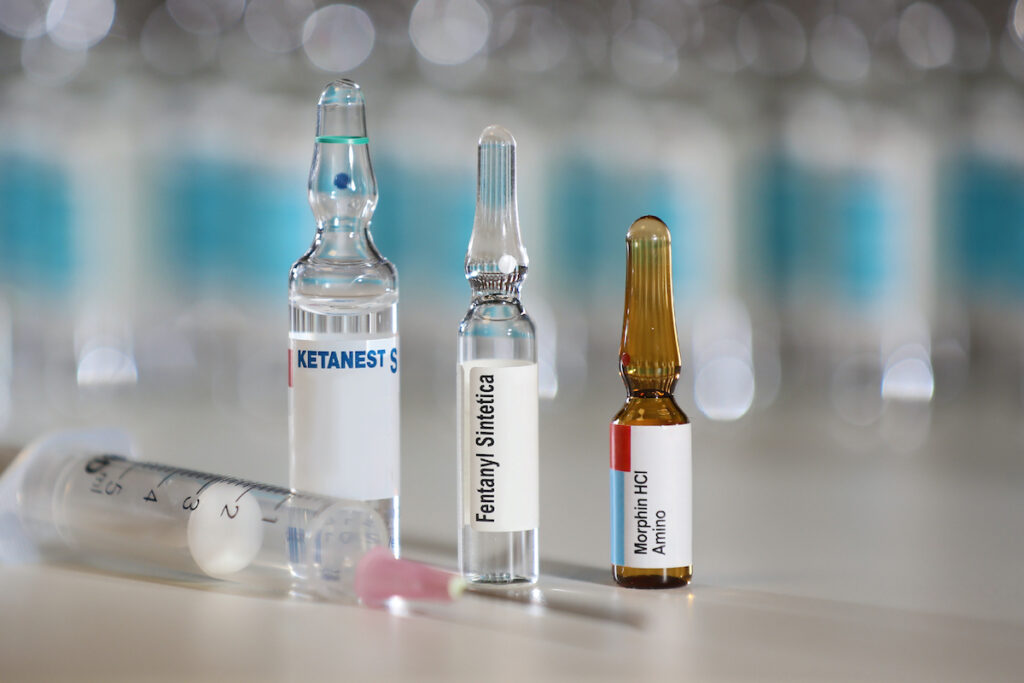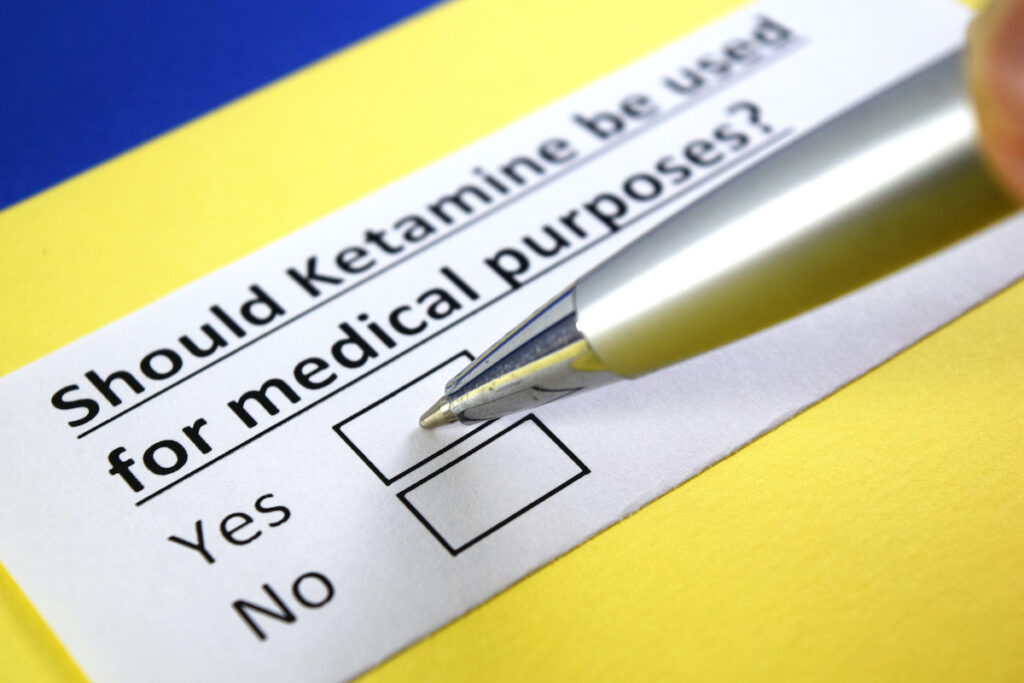
Is ketamine a viable treatment option for those with ‘treatment resistant depression’? The potential is there, but recent evidence is mixed.
‘Treatment resistant depression’ (TRD) affects up to 30% of depressed patients (McLachlan, 2018). Electroconvulsive therapy (ECT) and transcranial magnetic stimulation (TMS) are well-established treatments for TRD, but these therapies sometimes are not an option due to side effects (e.g. short-term memory loss, headache), non-responsiveness and ineligibility of people with comorbidities, such as epilepsy or metal head implants (Cristancho et al., 2013; Griffiths et al., 2019). The need for novel and effective treatments for TRD still remains critical.
In March 2019, the U.S Food and Drug Administration (FDA) approved esketamine, a nasal spray containing ketamine, to be used alongside oral antidepressants for treating TRD in adults. Contrastingly, in the UK esketamine has been rejected twice by NICE guidelines due to uncertainties around the cost-effectiveness of providing it in NHS settings (Daly et al., 2018).
Importantly, these rejections by NICE do not reflect ketamine’s effectiveness at treating depression, but indicates the lack of evidence available on the safety, long-term effects and feasibility of ketamine treatment (Serafini et al., 2014). Various forms of ketamine have been trialled to treat depressive symptoms, and recent studies have indicated that ketamine may induce strong, albeit mostly short-lived, anti-depressive effects (Coyle et al., 2015).
This paper aims to explore through in-depth qualitative interviews patients experiences and response to ketamine infusion treatment as a potential treatment for TRD.

Ketamine is a rapid-acting antidepressant, which could be a hopeful alternative for severely depressed patients who have not been helped by other treatments.
Methods
Semi-structured interviews were carried out with 13 participants with a diagnosis of TRD and who had experience of ketamine infusion treatment (3 sessions).
Most of the interviews were carried out over the telephone, with two of the interviews taking place face-to-face. The questions explored areas such as:
- Their decisions around deciding to try ketamine treatment
- Their experience during and following the ketamine infusion
- Life changes that they may have experienced following the ketamine treatment.
The interview data was analysed using interpretative phenomenological analysis (IPA) (Smith, 2007).
Results
Themes were identified:
1. Reasons for trying ketamine treatment
The majority of participants were desperate for ‘something new’ to help with their depression and felt that the benefits of taking the ketamine treatment outweighed the risks. They also said that establishing a good rapport with their clinical team increased their willingness to take the treatment.
2. Experiences of the ketamine treatment
This was divided into five sub-themes:
- Physiological: During the infusion, participants felt dissociated, relaxed, ‘floaty’, and experienced heightened senses, such as seeing more vibrant colours. Unpleasant physiological side effects included nausea, headaches and feeling panicky. For three participants, these adverse physiological effects were so severe (including ‘horrific hallucinations’) that their treatment was stopped prematurely.
- Emotional: Several participants reported feeling happier and having an overall mood lift during the infusion and a few days after, while some of them felt ‘normal’ and back to their ‘true self’.
- Behavioural: Various changes related to behaviour were also reported, including improved sleep, increased motivation for daily activities. and increased desire to socialise and communicate with others, which in turn improved some relationships.
- Cognitive: Participants reported being able to reframe their thinking more positively, and experience more future-focused thinking. Half of participants reported that suicidal ideation was reduced, while thoughts of improved self-worth and an ability to see a future were more prominent. Some participants said that ketamine was ‘life-changing’.
- Treatment enhancers: Participants agreed that the environment in which they received the ketamine treatment was important: a safe and conducive environment with caring, trusted staff helped with making the experience positive.
3. Barriers to treatment efficacy
Three participants did not report any anti-depressive effects. In the remaining participants who did feel some anti-depressive effects, these effects differed in duration. Furthermore, participants described how negative external factors (e.g. seeing another patient respond to the treatment negatively whilst in the same room, or having unfamiliar staff) decreased the treatment experience and overall effect.
4. Advocating the ketamine treatment
Regardless of their own experience of the ketamine infusion treatment, all the participants agreed that others should try and have access to the treatment.

Ketamine infusion heightened senses, increased motivation and enhanced mood and cognitive abilities for some participants, while provoked unpleasant physiological side effects for others.
Conclusions
The authors concluded that:
- Ketamine for depression can be beneficial and “potentially life-transforming for some”.
- Ketamine may provide a hopeful, alternative option for those who have TRD. However, for some patients ketamine did not have any effect at all, or induced adverse side effects.
- The results fitted with other studies that have found a recurring trajectory: ketamine causes an initial rapid anti-depressive effect, which trails off after a few days. However it’s important to note that this was not the case for all participants, as some participants did not experience any anti-depressive effects and some experienced strong adverse side effects; hence it’s difficult to draw concrete conclusions.
- The psychological and environmental context in which ketamine is administered is very important as it can affect the treatment’s efficacy.

Negative external factors, such as having unfamiliar staff or seeing other patients having an adverse reaction to the treatment, decreased the reported ketamine treatment efficacy and success.
Strengths and limitations
The use of interpretative phenomenological analysis (IPA) was an appropriate method for collecting and analysing the interview data as it meant that the personal accounts of the participants’ ketamine experiences could be captured. The study discovered some interesting insights. I particularly thought that the reporting of increased motivation to do daily tasks and ability to reframe thoughts a really promising finding, especially for this population. The study also reported treatment enhancers and barriers, which gives an insight into how viable it may be to provide ketamine treatment to a wider TRD population.
An obvious limitation of the study was the small sample of 13 participants who were recruited from the same site, as it decreases the ability to generalise the results to the wider population. However, recruiting a larger sample from various sites was not an option as there are currently only two clinics in the UK offering ketamine treatment. Unfortunately, all participants were White British, which further reduces the study’s generalisability, as TRD affects all ethnicities and it’s important for the research sample to reflect the target population being studied as much as possible (Rizvi et al., 2014). The participants had a massive range of ketamine sessions (3-112), so it would have been interesting to find out whether the number of ketamine sessions affected the participant’s experience.

The small participant sample is a side-effect of the fact that there are only two clinics in the UK currently offering ketamine treatment.
Implications for practice
This study was important as it identified factors that affected the treatment experience, which can be used to improve treatment efficacy and gives an insight into how practical it may be to integrate ketamine treatment within clinical services for TRD patients. The study also gave some novel insights into the patient experience of ketamine treatment for TRD.
Future studies could look into the longitudinal effects (including adverse effects, safety and tolerability) and experiences of ketamine treatment, such as:
- Are the positive effects of ketamine long-lasting?
- What proportion of treatment recipients report adverse side effects, and what are the long-term impact of these side effects?
- Does long-term ketamine treatment lead to some of the problems that we already know that ketamine can cause, such as bladder damage?
- How cost-effective is ketamine treatment?
Overall, this study showed that ketamine infusion treatment can potentially be a positive experience for TRD patients. I think more research is required into the safety and feasibility of ketamine before we can begin to start thinking about introducing ketamine as a treatment for ‘treatment resistant depression’ in the NHS.

Future studies should investigate the cost-effectiveness of ketamine treatment, as this evidence is lacking in the UK.
Statement of interests
The author, Harmony Jiang, has previously worked in the trust where the research took place, in which she worked with CG on a non-related study.
Links
Primary paper
Griffiths C, Walker K, Reid I. et al (2021) A qualitative study of patients’ experience of ketamine treatment for depression: The ‘Ketamine and me’ project. Journal of Affective Disorders 2021 4 100079.
Other references
Coyle, C. M. and Laws, K. R. (2015) The use of ketamine as an antidepressant: a systematic review and meta-analysis. Hum. Psychopharmacol Clin Exp, doi: 10.1002/hup.2475.
Cristancho M, Helmer A, Connolly R. et al (2013) Transcranial Magnetic Stimulation (TMS) Maintenance as a Substitute for Maintenance Electroconvulsive Therapy (ECT) – A Case Series. The Journal of ECT 2013 29(2) 106-108.
Daly E, Singh J, Fedgchin M. et al (2018) Efficacy and Safety of Intranasal Esketamine Adjunctive to Oral Antidepressant Therapy in Treatment-Resistant Depression: A Randomized Clinical Trial. JAMA Psychiatry. 2018;75(2):139-148.
Griffiths C, O’Neill-Kerr A, Millward T. et al (2019) Repetitive transcranial magnetic stimulation (rTMS) for depression: outcomes in a United Kingdom (UK) clinical practice. International Journal of Psychiatry in Clinical Practice 2019 23(2) 122-127.
McLachlan G (2018) Treatment resistant depression: what are the options? BMJ 2018 163(1) k5354.
Rizvi SJ, Grima E, Tan M. et al (2014) Treatment-Resistant Depression in Primary Care Across Canada. Can J Psychiatry 59(7) 349-357.
Serafini G, Howland RH, Rovedi F. et al (2014) The Role of Ketamine in Treatment-Resistant Depression: A Systematic Review. Current Neuropharmacology 2014 12(5) 444-461.
Smith J (2007) Hermeneutics, human sciences and health: linking theory and practice. International Journal of Qualitative Studies on Health and Well-being 2007 2(1) 3-11.
Photo credits
- Photo by Werner Du plessis on Unsplash
